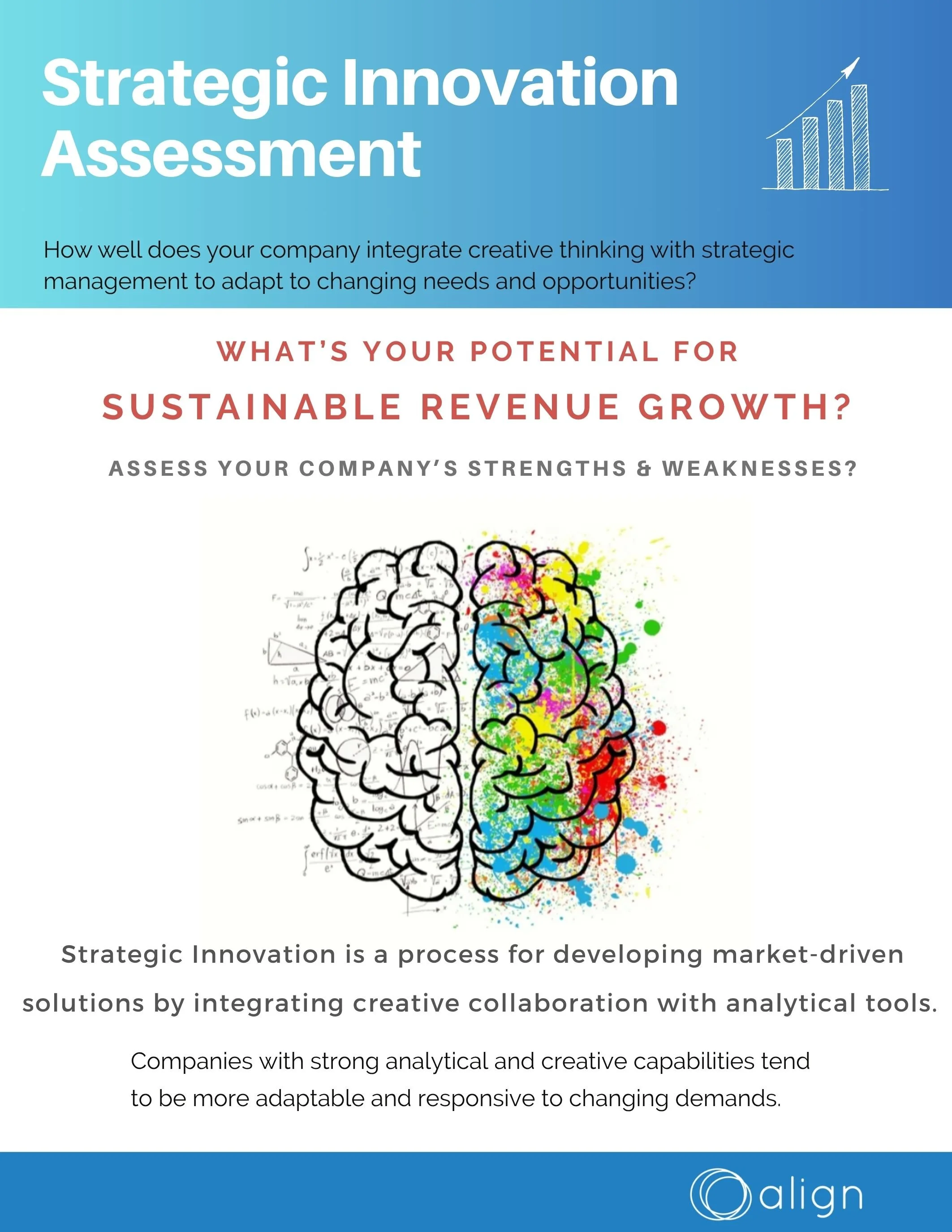
Strategic Planning
When your success depends on creating new value with new ideas or new approaches,
you need a proven process that drives strategic innovation, not just planning.
Your playbook for winning
As your organization’s playbook for winning, your strategic plan needs to be refreshed frequently to respond to changing demands. But, planning without creative thinking may not generate the breakthroughs you need to move the needle and make a real difference for your stakeholders.
Adapting to Change
Declining revenue, slow progress, or lack of shared vision can be symptoms of an outdated strategy. If you’re not moving forward fast enough, it’s easy to fall behind. Stagnation is a risk that’s hard to see from the inside. Successful organizations dedicate time to evolving their strategy to stay ahead.
Today, strategic planning has evolved to Strategic Innovation - a structured and inspired process that combines research, analysis, and creative thinking. To uncover new approaches and create new value for stakeholders and customers, you need a process that helps people imagine new possibilities.
You can’t invent new solutions with traditional planning. You need rich external insights, tools to help you think differently about the challenges, and techniques that encourage people to unleash their wild ideas and dreams.
The Future Demands Innovation
A Proven Process
To uncover new sources of revenue, new audiences, new services, new levels of community impact, or new ways of working, you need a process designed to generate insights and ideas.
Align uses its 4 I’s of Strategic Innovation framework to customize a strategic planning approach that addresses your specific needs. Our human-centered process consists of research and stakeholder engagement, creative thinking and group facilitation, and collaborative prioritization that pulls it all together. We’re process experts and skilled facilitators who lead you through the right activities. Whether you lead a non-profit, a business, or a public sector organization, we’ve got you covered. Our process can be adjusted to meet special requirements and adapted for any size organization.
A Strategic Planning Process Designed for Innovation
Discovery &
Insights
We work with your advisory group to clarify the internal and external stakeholders whose input matters most and how we’ll bring their voices to the process. Then we may conduct interviews, focus groups, forums, and/or surveys, combined with identifying industry trends and promising practices.
Collaboration & Ideas
This information is synthesized into a stakeholder needs workshop that enables your team to discuss the findings, reflect on current services with fresh eyes, and brainstorm new ways to address your stakeholders’ priorities.
Strategy Development
Objectives are prioritized into a framework that describes what to offer stakeholders and how to operate and deliver results efficiently. These top 2-4 priorities pull the most promising opportunities into alignment for a plan that’s actionable and measurable.
Implementation Kickoff
This information is synthesized into a stakeholder needs workshop that enables your team to discuss the findings, reflect on current services with fresh eyes, and brainstorm new ways to address your stakeholders’ priorities.
Client
Results
-
You took all of our ideas, turned it into a cohesive plan that was right for us, then helped us roll out critical projects.
— Mike Molla, President
-
The Strategic Plan you created for us is working! We’ve grown membership and revenue, had success with our new programs, and even attracted new board members. I wanted you to know that a year later, your work has made a big difference!
— Ann Hughes, President
-
I really like how you started with the customer needs and our value proposition instead of budget and revenue goals. I can see how this new strategy will lead to revenue growth because we’ll be offering more of what our clients want.
— Bruce Newell, CEO
-
We couldn’t be more excited about the new direction. This will take a lot of work, but you’ve given us such a solid framework for what needs to be done and the team is really owning it.
— Jessica Muoff, President
Where should you start?
Assess your company’s
Strategic Innovation Capacity.
Are you curious about your organization’s strengths and weaknesses related to strategy and innovation?
Are there issues that prevent creative ideas?
Is there a gap converting strategy into action?
Do you have practices that facilitate innovation?
Get Expert Advice
•
Get Expert Advice •
Let’s meet! Take the lead by exploring your best options.
Schedule a free meeting to discuss your unique situation and get recommendations for the best path forward.




